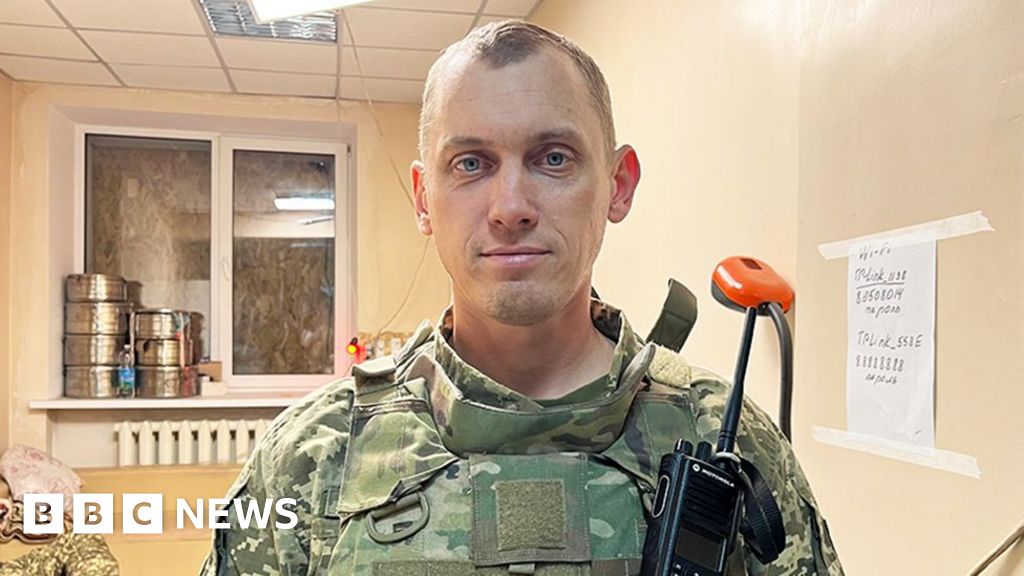 Imogen Anderson/BBC
Imogen Anderson/BBC“This is the most dangerous of all front lines,” says Oleksandr, the head of a medical unit for the Ukrainian army’s 25th Brigade.
We are in the treatment room of a cramped makeshift field unit – the first point of treatment for injured soldiers.
“The Russian Federation is pushing very hard. We have not been able to stabilise the front. Each time the front line moves, we also move.”
We are close to Pokrovsk, a small mining city about 60km (37 miles) to the north-west of the regional capital, Donetsk.
The medics tell us they recently treated 50 soldiers in one day – numbers rarely seen before during the course of this war. The casualties are brought in for treatment at this secret location after dusk, when there is less of a chance of being attacked by armed Russian drones.
The Ukrainian troops have been injured in the ferocious battle to defend Pokrovsk. Just months ago, this was considered a relatively safe place – home to about 60,000 people, its streets lined with restaurants, cafes and markets. Soldiers would often come from the front line to the city for a break.
Now, it feels like a ghost town. More than three-quarters of its population have left.
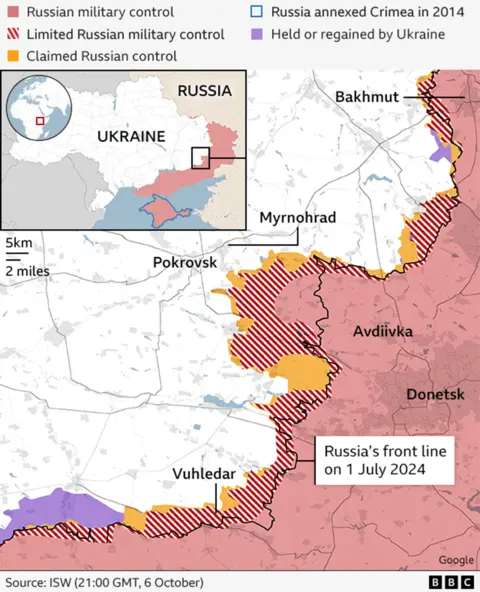
Since Russia captured the city of Avdiivka in February, the speed of its advance in the Donestk region has been swift. At the start of October, it captured the key city of Vuhledar.
The Ukrainian government agrees with the soldiers we meet on the ground, that fighting around Pokrovsk is the most intense.
“The Pokrovsk direction leads the number of enemy attacks,” Kyiv stated this week – claiming that, in total, the Armed Forces of Ukraine had repelled about 150 “enemy” attacks on most days in the past two weeks.
In the field unit, six miles from the front, army medic Tania holds the arm of Serhii, a soldier with a bloodied bandage covering most of his face, and guides him into an examination room.
“His condition is serious,” says Tania.
Serhii has shrapnel injuries to one of his eyes, his skull and brain. The doctors quickly clean up his wounds and inject antibiotics.
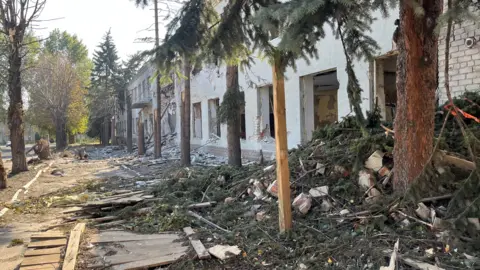 Imogen Anderson / BBC
Imogen Anderson / BBCFive more soldiers arrive soon after – they are uncertain how they received their injuries. The barrage of fire can be so fierce and sudden, their wounds could have been caused by mortars or explosives dropped from drones.
“It’s dangerous here. It is difficult, mentally and physically. We are all tired, but we are coping,” says Yuriy, the commander of all the brigade’s medical units.
All the soldiers we see were injured at different times of the morning, but they have only arrived after nightfall, when it is safer.
Such delays can increase the risk of death and disability, we are told.
Another soldier, Taras, has tied a tourniquet around his arm to stop the bleeding from a shrapnel wound, but now – more than 10 hours later – his arm looks swollen and pale and he can’t feel it. A doctor tells us it might have to be amputated.
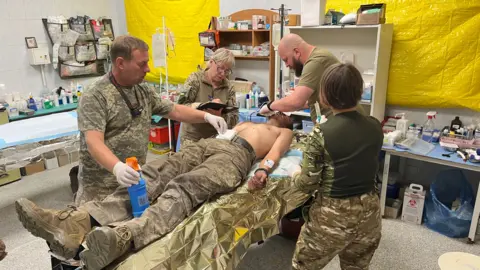 Imogen Anderson / BBC
Imogen Anderson / BBCIn the past 24 hours, two soldiers have been brought in dead.
What we see at the field unit points to the ferocity of the battle for Pokrovsk – an important transport hub. The rail link that passes through was used regularly to evacuate civilians from front-line towns to safer parts of Ukraine, and to move supplies for the military.
Ukraine knows what is at stake here.
The threat of Russian drones is ever present – one hovers just outside the medical unit while we are there. It makes evacuations from the front line extremely hard. The building’s windows are boarded up so the drones can’t look inside, but the minute anyone steps out of the door, they are at risk of being hit.
The drones are also a threat to the remaining citizens of Pokrovsk.
“We constantly hear them buzzing – they stop and look inside the windows,” says Viktoriia Vasylevska, 50, one of the remaining, war-weary residents. But even she has now agreed to be evacuated from her home, on the particularly dangerous eastern edge of the city.
She is surprised by how fast the front line has moved west towards Pokrovsk.
“It all happened so quickly. Who knows what will happen here next. I’m losing my nerve. I have panic attacks. I’m afraid of the nights.”
Viktoriia says she has barely any money and will have to start her life from scratch somewhere else, but it is too scary to stay here now.
“I want the war to end. There should be negotiations. There is nothing left in the lands taken by Russia anyway. Everything is destroyed and all the people have fled,” she says.
 Yogita Limaye / BBC
Yogita Limaye / BBCWe find eroded morale among most of the people we speak to – the toll of more than two and a half years of a grinding war.
Most of Pokrovsk is now without power and water.
At a school, there is a queue of people carrying empty canisters waiting to use a communal tap. They tell us that a few days ago, four taps were working, but now they are down to just one.
Driving through the streets, pockets of destruction are visible, but the city hasn’t yet been bombed out like others that have been fiercely fought over.
We meet Larysa, 69, buying sacks of potatoes at one of a handful of food stalls still open at the otherwise shuttered-down central market.
“I’m terrified. I can’t live without sedatives,” she says. On her small pension, she doesn’t think she would be able to afford rent somewhere else. “The government might take me somewhere and shelter me for a while. But what after that?”
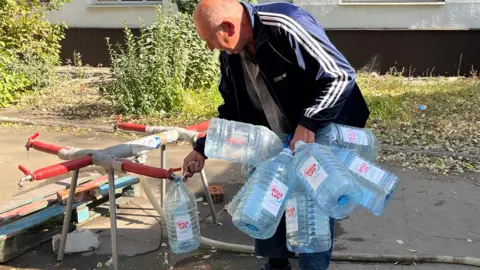 Imogen Anderson / BBC
Imogen Anderson / BBCAnother shopper, 77-year-old Raisa chimes in. “You can’t go anywhere without money. So we just sit in our home and hope that this will end.”
Larysa thinks it’s time to negotiate with Russia – a sentiment that might have been unthinkable for most in Ukraine some time ago. But at least here, near the front line, we found many voicing it.
“So many of our boys are dying, so many are wounded. They’re sacrificing their lives, and this is going on and on,” she says.
From a mattress on the floor of an evacuation van, 80-year-old Nadiia has no sympathy for the advancing Russian forces. “Damn this war! I’m going to die,” she wails. “Why does [President] Putin want more land? Doesn’t he have enough? He has killed so many people.”
Nadiia can’t walk. She used to drag herself around her house, relying on the help of neighbours. Just a handful of them have stayed back, but under the constant threat of bombardment, she has decided to leave even though she doesn’t know where she will go.
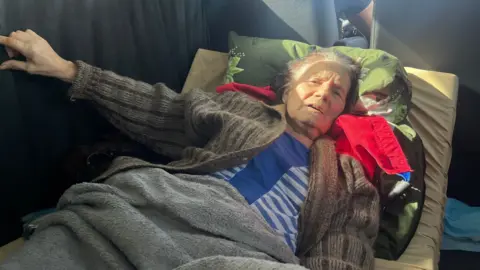 Yogita Limaye / BBC
Yogita Limaye / BBCBut there are those who are not yet leaving town.
Among them are locals working to repair war-damaged infrastructure.
“I live on one of the streets closest to the front line. Everything is burnt out around my house. My neighbours died after their home was shelled,” Vitaliy tells us, as he and his co-workers try to fix electrical lines.
“But I don’t think it’s right to abandon our men. We have to fight until we have victory and Russia is punished for its crimes.”
His resolve is not shared by 20-year-old Roman, who we meet while he is working to fix a shell-damaged home.
“I don’t think the territory we’re fighting for is worth human lives. Lots of our soldiers have died. Young men who could have had a future, wives and children. But they had to go to the front line.”
 Imogen Anderson / BBC
Imogen Anderson / BBCAt dawn one morning, we drive towards the battlefield outside the city. Fields of dried sunflowers line the sides of the roads. There is barely any cover, and so we drive at breakneck speed in order to protect ourselves against Russian drone attacks.
We hear loud explosions as we near the front line.
At a Ukrainian artillery position, Vadym fires a Soviet-era artillery gun. It emits a deafening sound and blows dust and dried leaves off the ground. He runs to shelter in an underground bunker, keeping safe from Russian retaliation and waiting for the coordinates of the next Ukrainian strike.
“They [Russia] have more manpower and weapons. And they send their men onto the battlefield like they’re canon fodder,” he says.
But he knows that if Pokrovsk falls, it could open a gateway to the Dnipro region – just 32km (20 miles) from Pokrovsk – and their job will become even more difficult.
“Yes, we are tired – and many of our men have died and been wounded – but we have to fight, otherwise the result will be catastrophic.”
Additional reporting by Imogen Anderson, Anastasiia Levchenko, Volodymyr Lozhko, Sanjay Ganguly

